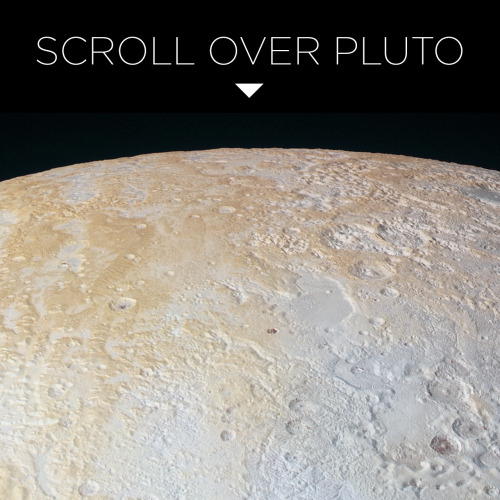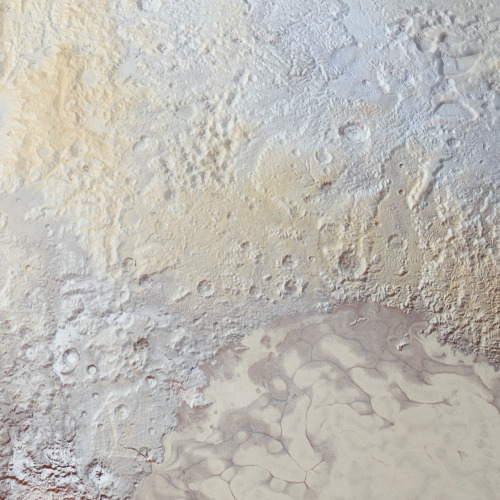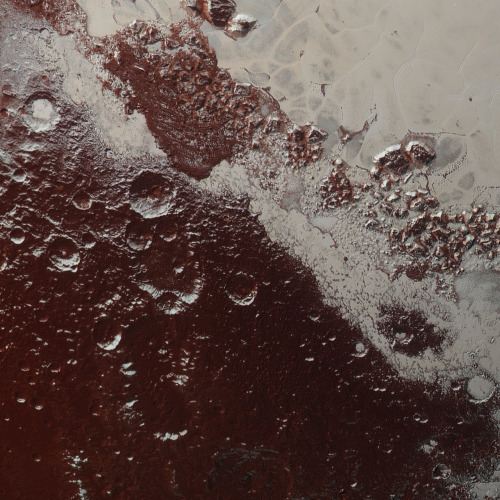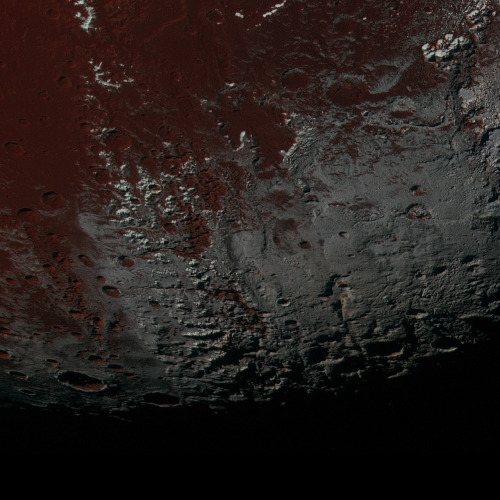Black Holes Are Real And Spectacular, And So Are Their Event Horizons










Black Holes Are Real And Spectacular, And So Are Their Event Horizons
“Originally estimated to be slightly larger than its M87 counterpart, the black hole at the center of the Milky Way — known as Sagittarius A* — has not yet had its event horizon imaged. When you observe the Universe, you don’t always get what you expect; sometimes, you get what it gives you. Instead, it was M87’s black hole that came through first, which was a much brighter and a much cleaner signal.
What we’ve found is spectacular. Those dark pixels at the center of the image are actually the silhouette of the event horizon itself. The light that we observe comes from the accelerated, heated matter around it, which must emit electromagnetic radiation. Where the matter exists, it emits radio waves, and the dark circle we see is where the background radio waves are blocked by the event horizon itself.”
We have an event horizon, folks! It wasn’t the one at the center of our galaxy that came through first, but rather the one at the center of Messier 87: a black hole over 1,000 times more massive, but some 2,000 times farther away, than the one contained in the Milky Way. This is an ultramassive black hole that’s almost the size of the entire Solar System, and its event horizon is real.
Come get the full story on what we know, now that we have our image, about black holes in the aftermath of the Event Horizon Telescope!
More Posts from Fillthevoid-with-space and Others



Description: A four panel comic. In the first two panels, me and my father are squinting at the night sky before I brighten and declare that ‘OH! I see it!’ In the next panel is the night sky with two stars. One bright one in the lower right center and a slightly dimmer one just above and to the left of the first one. Text reads: ‘This year, on December 21st, Jupiter and Saturn will line up, creating the ‘Christmas Star’ not seen for almost 400 years. In the days leading up to it, you can see Jupiter shine brightly, with Saturn faintly shining just above it.’ In the final panel I am closing my window and looking up at the sky. Captions read: ‘I keep looking up, finding and refinding it.’ And ‘The planets are always there, but this moment makes it all seem so fleeting.’
Just a reminder that the first NASA astronauts were supposed to be women because generally they are smaller, lighter (less weight in the cockpit means less fuel required) and eat less than men and so would be easier to accommodate in space.
What are the most important skills an astronaut should have m?
First of all, the basic requirement is a bachelor’s degree in a STEM field, and 3 years of experience (which can also be substituted for by an advanced degree). Other than that, operational experience (things with a technical/active/hands on nature like flying airplanes, SCUBA diving, taking things apart and putting them back together, basic fix-it skills, etc. etc.) is very important, as this is an integral aspect of every day of a space mission. What we call “expeditionary skills” are also essential, basically the types of things you try to instill in your children, like how to play nicely with others, self care, team care, etc. I like to think about this on the lines of a camping trip and who you would like to have along with you …someone that is competent and can take good care of themselves and their equipment, someone that contributes to the team and helps with group tasks, someone that is good natured and pleasant to be around, etc., someone fun! These things are increasingly important now that we are regularly doing long duration missions (typical International Space Station mission is 6 months). Experience living in extreme/remote/isolated environments with small teams is also useful, as it is similar to what we experience as astronauts.
The Past, Present and Future of Exploration on Mars
Today, we’re celebrating the Red Planet! Since our first close-up picture of Mars in 1965, spacecraft voyages to the Red Planet have revealed a world strangely familiar, yet different enough to challenge our perceptions of what makes a planet work.

You’d think Mars would be easier to understand. Like Earth, Mars has polar ice caps and clouds in its atmosphere, seasonal weather patterns, volcanoes, canyons and other recognizable features. However, conditions on Mars vary wildly from what we know on our own planet.
Join us as we highlight some of the exploration on Mars from the past, present and future:
PAST
Viking Landers

Our Viking Project found a place in history when it became the first U.S. mission to land a spacecraft safely on the surface of Mars and return images of the surface. Two identical spacecraft, each consisting of a lander and an orbiter, were built. Each orbiter-lander pair flew together and entered Mars orbit; the landers then separated and descended to the planet’s surface.

Besides taking photographs and collecting other science data, the two landers conducted three biology experiments designed to look for possible signs of life.
Pathfinder Rover

In 1997, Pathfinder was the first-ever robotic rover to land on the surface of Mars. It was designed as a technology demonstration of a new way to deliver an instrumented lander to the surface of a planet. Mars Pathfinder used an innovative method of directly entering the Martian atmosphere, assisted by a parachute to slow its descent and a giant system of airbags to cushion the impact.

Pathfinder not only accomplished its goal but also returned an unprecedented amount of data and outlived its primary design life.
PRESENT
Spirit and Opportunity

In January 2004, two robotic geologists named Spirit and Opportunity landed on opposite sides of the Red Planet. With far greater mobility than the 1997 Mars Pathfinder rover, these robotic explorers have trekked for miles across the Martian surface, conducting field geology and making atmospheric observations. Carrying identical, sophisticated sets of science instruments, both rovers have found evidence of ancient Martian environments where intermittently wet and habitable conditions existed.

Both missions exceeded their planned 90-day mission lifetimes by many years. Spirit lasted 20 times longer than its original design until its final communication to Earth on March 22, 2010. Opportunity continues to operate more than a decade after launch.
Mars Reconnaissance Orbiter

Our Mars Reconnaissance Orbiter left Earth in 2005 on a search for evidence that water persisted on the surface of Mars for a long period of time. While other Mars missions have shown that water flowed across the surface in Mars’ history, it remained a mystery whether water was ever around long enough to provide a habitat for life.

In addition to using the rover to study Mars, we’re using data and imagery from this mission to survey possible future human landing sites on the Red Planet.
Curiosity

The Curiosity rover is the largest and most capable rover ever sent to Mars. It launched November 26, 2011 and landed on Mars on Aug. 5, 2012. Curiosity set out to answer the question: Did Mars ever have the right environmental conditions to support small life forms called microbes?

Early in its mission, Curiosity’s scientific tools found chemical and mineral evidence of past habitable environments on Mars. It continues to explore the rock record from a time when Mars could have been home to microbial life.
FUTURE
Space Launch System Rocket

We’re currently building the world’s most powerful rocket, the Space Launch System (SLS). When completed, this rocket will enable astronauts to begin their journey to explore destinations far into the solar system, including Mars.
Orion Spacecraft

The Orion spacecraft will sit atop the Space Launch System rocket as it launches humans deeper into space than ever before. Orion will serve as the exploration vehicle that will carry the crew to space, provide emergency abort capability, sustain the crew during the space travel and provide safe re-entry from deep space return velocities.
Mars 2020

The Mars 2020 rover mission takes the next step in exploration of the Red Planet by not only seeking signs of habitable conditions in the ancient past, but also searching for signs of past microbial life itself.

The Mars 2020 rover introduces a drill that can collect core samples of the most promising rocks and soils and set them aside in a “cache” on the surface of Mars. The mission will also test a method for producing oxygen from the Martian atmosphere, identify other resources (such as subsurface water), improve landing techniques and characterize weather, dust and other potential environmental conditions that could affect future astronauts living and working on the Red Planet.

For decades, we’ve sent orbiters, landers and rovers, dramatically increasing our knowledge about the Red Planet and paving the way for future human explorers. Mars is the next tangible frontier for human exploration, and it’s an achievable goal. There are challenges to pioneering Mars, but we know they are solvable.
To discover more about Mars exploration, visit: https://www.nasa.gov/topics/journeytomars/index.html
Make sure to follow us on Tumblr for your regular dose of space: http://nasa.tumblr.com

After over a century of observations and several theories, scientists may have finally nailed the origin of the high-speed plasma blasting through the Sun’s atmosphere several times a day. Using a state-of-the-art computer simulation, researchers have developed a detailed model of these plasma jets, called spicules.
The new findings answer some of the bigger questions in solar physics, including how these plasma jets form and why the Sun’s outer atmosphere is far hotter than the surface.
“This is the first model that has been able to reproduce all the features observed in spicules,” Juan Martinez-Sykora, lead author and astrophysicist at the Bay Area Environmental Research Institute in California, told ScienceAlert.
Continue Reading.
Does space have a standard time or do you rely on the time zones on Earth while you are in space?
Great question. Really it is up to the particular space agency/mission which time zone they use. For example, since the International Space Station is a collaboration between NASA, the Russian Space Agency, the European Space Agency, the Japanese Space Agency, and the Canadian Space Agency, we came up with the compromise of operating on Greenwich Mean Time (GMT). So, Space Station time is the same as London time! The International Space Station orbits our planet every 90 minutes, so of course we’re transiting across multiple time zones constantly.

(I broke the last link, whoops)
Another week of theory, but no fun new particles. Instead, hear me try to say a lot of names of scientists or their eponymous equations as I talk about dark energy in the universe! Learn what some astronomers think it is and why other astronomers think there are better explanations for certain nutty galactic phenomena.
Below the cut are my sources, music credits, a vocab list, and the transcript of this episode. Let your voice be heard and tell me what you think I should research next by messaging me here, tweeting at me at @HDandtheVoid, or asking me to my face if you know me in real life. And please subscribe to the podcast on iTunes, rate it and maybe review it, and tell friends if you think they’d like to listen!
(If anything about dark matter or dark energy or cosmic microwave background radiation confused you over the past few podcasts, for sure send me your questions so I can ask someone more qualified than me—my doctorate student friend! My thoughts on the next episode are still the Voyager golden records, space race history, the transit of Venus, the Moon landing, Edmond Halley, or Dark Sky Preserves and it will be up on November 20th.)
Glossary
baryons - heaviest particles. Ex. Protons, neutrons. In astroparticle physics, electrons are included in baryonic matter.
cosmic microwave background radiation - the electromagnetic radiation left over from the time of recombination in Big Bang cosmology.
dark energy - a theoretical force made up of unknown, undetectable energy. It is used to explain why the universe is expanding more rapidly over time instead of slowing its expansion.
dark matter - a theoretical mass made up of unknown particles that have not been created on Earth. It is used to explain why galaxy clusters have 10x the mass that their light output suggests they would have; why distant stars on the edges of spiral galaxies orbit at the same speed as stars near the center of the galaxy; and the accretion of gases that created galaxies at the beginning of the universe.
fundamental forces - four fundamental forces in our current model of the universe: the strong and weak nuclear forces, the electromagnetic force, and gravity.
gravitational lensing - when light from more distant sources passes near a massive star, galaxy, or galaxy cluster and the object’s gravity bends the light like a lens to provide a warped angle view of space.
Transcript
Sources
Dark energy via NASA
Dark energy via Hubble
“The strangeness of dark energy is thrilling.”
Fundamental forces via Georgia State University
Dark energy via Science Magazine (April 2017)
László Dobos: “We assume that every region of the universe determines its expansion rate itself.”
Dark energy and the South Pole Telescope via Smithsonian Magazine (April 2010)
“Knowing what dark matter is would help scientists think about how the structure of the universe forms. Knowing what dark energy does would help scientists think about how that structure has evolved over time—and how it will continue to evolve.”
Intro Music: ‘Better Times Will Come’ by No Luck Club off their album Prosperity
Filler Music: ‘Even The Darkness Has Arms’ by The Barr Brothers off their album The Sleeping Operator
Outro Music: ‘Fields of Russia’ by Mutefish off their album On Draught

Inner corona and prominences during Monday’s total solar eclipse
via reddit
-
 annita893e7cjr47h liked this · 7 months ago
annita893e7cjr47h liked this · 7 months ago -
 dancing-wombat reblogged this · 1 year ago
dancing-wombat reblogged this · 1 year ago -
 dancing-wombat reblogged this · 1 year ago
dancing-wombat reblogged this · 1 year ago -
 drilln liked this · 2 years ago
drilln liked this · 2 years ago -
 pulchriate liked this · 2 years ago
pulchriate liked this · 2 years ago -
 sebastian123sworld liked this · 3 years ago
sebastian123sworld liked this · 3 years ago -
 yapytaupeishasblog reblogged this · 3 years ago
yapytaupeishasblog reblogged this · 3 years ago -
 yapytaupeishasblog liked this · 3 years ago
yapytaupeishasblog liked this · 3 years ago -
 jits-posts liked this · 3 years ago
jits-posts liked this · 3 years ago
A podcast project to fill the space in my heart and my time that used to be filled with academic research. In 2018, that space gets filled with... MORE SPACE! Cheerfully researched, painstakingly edited, informal as hell, definitely worth everyone's time.
243 posts





